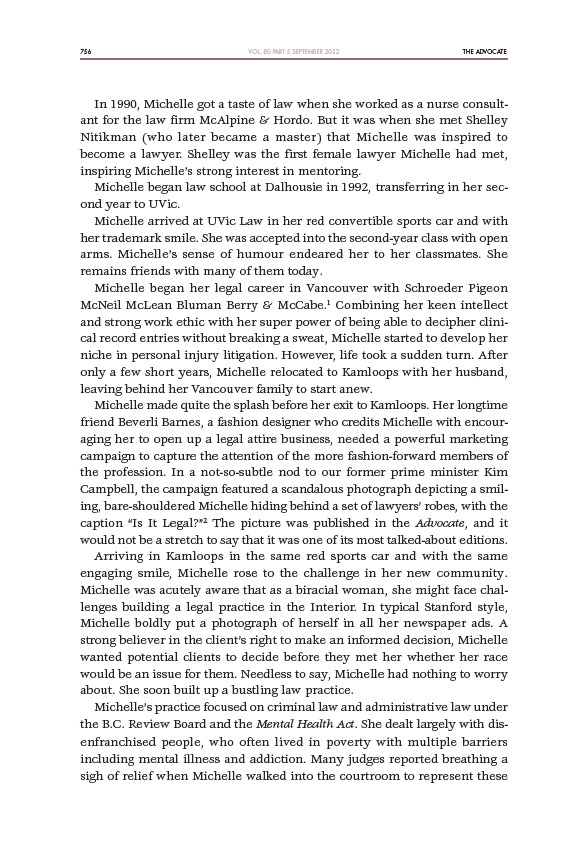
756 THE ADVOCATE
VOL. 80 PART 5 SEPTEMBER 2022
In 1990, Michelle got a taste of law when she worked as a nurse consultant
for the law firm McAlpine & Hordo. But it was when she met Shelley
Nitikman (who later became a master) that Michelle was inspired to
become a lawyer. Shelley was the first female lawyer Michelle had met,
inspiring Michelle’s strong interest in mentoring.
Michelle began law school at Dalhousie in 1992, transferring in her second
year to UVic.
Michelle arrived at UVic Law in her red convertible sports car and with
her trademark smile. She was accepted into the second-year class with open
arms. Michelle’s sense of humour endeared her to her classmates. She
remains friends with many of them today.
Michelle began her legal career in Vancouver with Schroeder Pigeon
McNeil McLean Bluman Berry & McCabe.1 Combining her keen intellect
and strong work ethic with her super power of being able to decipher clinical
record entries without breaking a sweat, Michelle started to develop her
niche in personal injury litigation. However, life took a sudden turn. After
only a few short years, Michelle relocated to Kamloops with her husband,
leaving behind her Vancouver family to start anew.
Michelle made quite the splash before her exit to Kamloops. Her longtime
friend Beverli Barnes, a fashion designer who credits Michelle with encouraging
her to open up a legal attire business, needed a powerful marketing
campaign to capture the attention of the more fashion-forward members of
the profession. In a not-so-subtle nod to our former prime minister Kim
Campbell, the campaign featured a scandalous photograph depicting a smiling,
bare-shouldered Michelle hiding behind a set of lawyers’ robes, with the
caption “Is It Legal?”2 The picture was published in the Advocate, and it
would not be a stretch to say that it was one of its most talked-about editions.
Arriving in Kamloops in the same red sports car and with the same
engaging smile, Michelle rose to the challenge in her new community.
Michelle was acutely aware that as a biracial woman, she might face challenges
building a legal practice in the Interior. In typical Stanford style,
Michelle boldly put a photograph of herself in all her newspaper ads. A
strong believer in the client’s right to make an informed decision, Michelle
wanted potential clients to decide before they met her whether her race
would be an issue for them. Needless to say, Michelle had nothing to worry
about. She soon built up a bustling law practice.
Michelle’s practice focused on criminal law and administrative law under
the B.C. Review Board and the Mental Health Act. She dealt largely with disenfranchised
people, who often lived in poverty with multiple barriers
including mental illness and addiction. Many judges reported breathing a
sigh of relief when Michelle walked into the courtroom to represent these